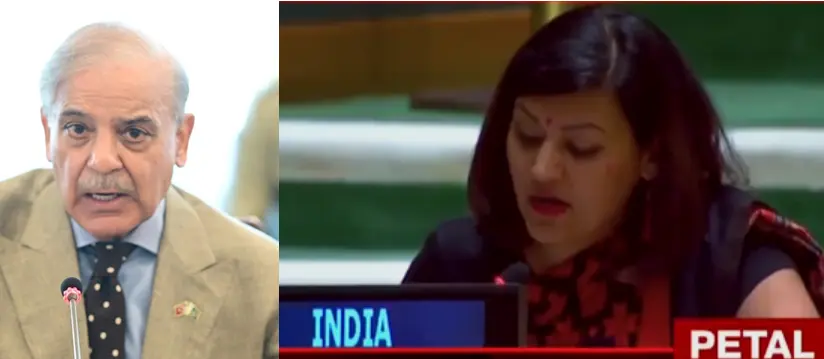
India counters Sharif’s UN claims, revealing Pakistan’s quiet plea for peace during Operation Sindoor
Why India Rejected Sharif’s UN Claims: Truth Behind Operation Sindoor and Pakistan’s Plea for Peace
| Rapid Updates
What Happened at the United Nations: Sharif’s Speech Sparks Controversy
At the 2025 United Nations General Assembly, Pakistan’s Prime Minister Shehbaz Sharif made strong remarks against India, accusing it of aggression and human rights violations in Jammu and Kashmir. He claimed that India’s military actions were destabilizing the region and violating international law.
Sharif’s speech was filled with emotional appeals, references to past conflicts, and calls for global intervention. He painted Pakistan as a victim of Indian hostility and demanded that the UN take action to stop what he called “Indian occupation.”
However, India responded swiftly and firmly. The Indian delegation dismissed Sharif’s claims as baseless and misleading. In a powerful rebuttal, India revealed that during Operation Sindoor, Pakistan’s own military had secretly pleaded for a ceasefire, unable to withstand the intensity of India’s counter-offensive.
India’s representative stated that Pakistan’s narrative at the UN was not only false but also hypocritical. While Sharif spoke of peace, his country continued to support cross-border terrorism and violated ceasefire agreements.
This exchange at the UN has reignited tensions between the two nuclear-armed neighbors and raised questions about the real story behind Operation Sindoor.
What Was Operation Sindoor: India’s Tactical Response to Provocations
Operation Sindoor was a strategic military operation launched by India in early 2025 in response to repeated ceasefire violations and infiltration attempts by Pakistan-backed militants along the Line of Control (LoC). The operation was named “Sindoor” to symbolize India’s protective strength—just as sindoor represents sacred protection in Indian tradition.
According to Indian defense sources, the operation was carefully planned and executed over several weeks. It involved:
- Precision strikes on militant launchpads across the LoC
- Surveillance drones to track infiltration routes
- Special forces deployment in high-risk zones
- Coordination with intelligence agencies to neutralize sleeper cells
The goal was not to escalate war but to send a clear message: India would no longer tolerate proxy terrorism or border violations.
During the operation, Indian forces reportedly gained control of key strategic points and dismantled several terror infrastructure hubs. The success of Operation Sindoor was widely praised within India and seen as a turning point in its counter-terrorism strategy.
What shocked many was the revelation that Pakistan’s military, overwhelmed by India’s precision and speed, had quietly reached out through backchannels requesting a cessation of hostilities. This plea contradicted Pakistan’s public stance and exposed a gap between its diplomatic rhetoric and military reality.
Why India Called Out Pakistan: The Truth About Ceasefire and Terror Links
India’s response at the UN was not just about defending its military actions—it was about exposing Pakistan’s double game. Indian officials highlighted several key points:
- Pakistan’s military plea for peace during Operation Sindoor showed that it was not prepared for a full-scale conflict and wanted to avoid further embarrassment.
- Sharif’s speech ignored Pakistan’s own violations, including support for terror groups like Lashkar-e-Taiba and Jaish-e-Mohammed.
- India’s actions were defensive, aimed at protecting civilians and soldiers from cross-border attacks.
- Pakistan’s narrative at the UN was politically motivated, designed to distract from its internal issues and economic crisis.
India also reminded the global community that it had consistently honored ceasefire agreements and sought peaceful dialogue. But when faced with repeated provocations, it had no choice but to respond firmly.
The Indian delegation’s statement was backed by intelligence reports, satellite imagery, and intercepted communications that confirmed Pakistan’s involvement in cross-border terrorism.
India’s message was clear: peace cannot be achieved through propaganda. It requires honesty, accountability, and a commitment to ending terrorism.
What This Means for India-Pakistan Relations: Hope or More Hostility?
The UN exchange between India and Pakistan has once again highlighted the fragile nature of their relationship. While both countries claim to want peace, their actions often tell a different story.
For India, the priority remains national security and protecting its borders. Operation Sindoor was a reflection of that commitment. The fact that Pakistan’s military sought a ceasefire shows that India’s strategy worked but it also reveals Pakistan’s vulnerability.
For Pakistan, the challenge is internal. With economic instability, political unrest, and global scrutiny, it needs to rebuild trust. But speeches like Sharif’s only deepen mistrust and isolate Pakistan diplomatically.
Experts believe that unless Pakistan takes real steps to dismantle terror networks and stop cross-border attacks, meaningful peace talks will remain out of reach.
However, there is still hope. Track-two diplomacy, cultural exchanges, and people-to-people connections can help bridge the gap. But for now, the focus is on truth, transparency, and strategic clarity.
India’s bold stance at the UN has set a precedent: emotional appeals won’t work unless backed by facts. And in the case of Operation Sindoor, the facts speak louder than any speech.
Get the latest news and insights—only on Rapido Updates.